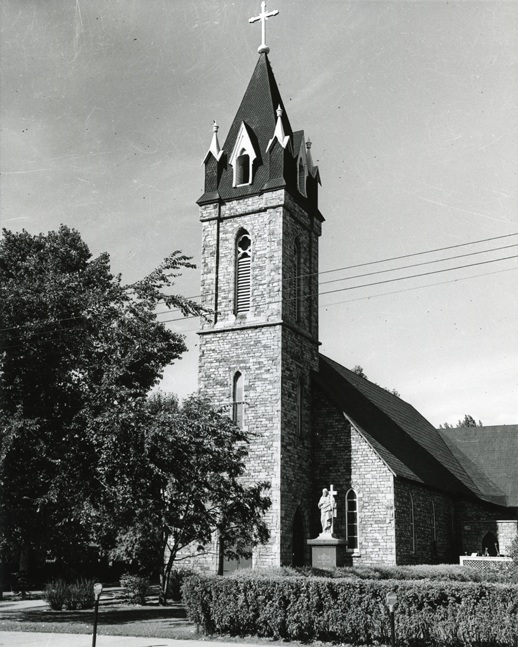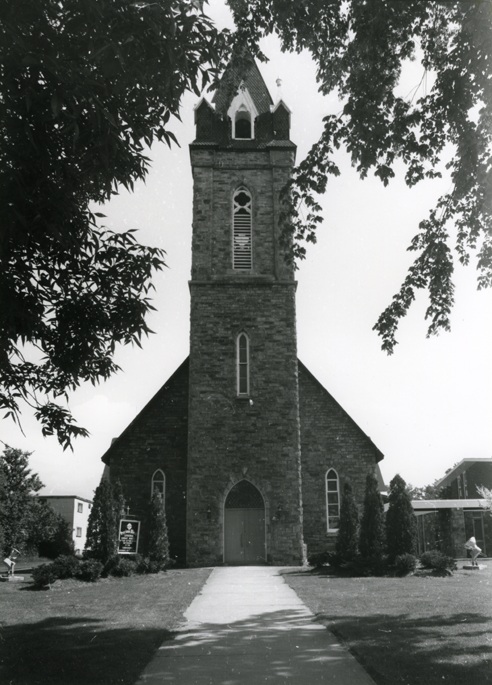
From the Sault Ste. Marie Public Library archives:
*************************
The Church of the Sacred Heart
The roots of the Roman Catholic religion in this area date back to about the fall of 1641 when there is a reference to two Jesuit priests celebrating the first mass with the Saulteaux Indians.
However due to the ongoing skirmishes between the French and English during the next century, visits by the Jesuits were infrequent and it would be many years before any permanent church building would be constructed in the area.
With the arrival of Bishop Alexander MacDonell from Scotland in 1804 he began to increase the presence of the Roman Catholic Church in Ontario and Sault Ste. Marie was considered to be geographically important and could be used as a hub to expand northwest.
 The oldest Roman Catholic Church in Sault Ste. Marie (continuing to occupy its’ original site) was built in 1875 and was named the Church of the Sacred Heart (later renamed Precious Blood Cathedral).
The oldest Roman Catholic Church in Sault Ste. Marie (continuing to occupy its’ original site) was built in 1875 and was named the Church of the Sacred Heart (later renamed Precious Blood Cathedral).
According to Alexander Vidal’s survey plan of 1846 for the Town of St. Mary’s (later Sault Ste. Marie) it shows that there is evidence of this location being used for a church and cemetery.
However there are some discrepancies as to the original owner of the plot of land now occupied by the church. According to some sources the property was donated to the Jesuits by Charles Ermatinger although other sources point to Andrew Hynes, the town’s first constable, or even well-known resident Joachim Biron as being the original owners.
All of these individuals had property in the area surrounding the site of the Church of the Sacred Heart.
The construction of the Church of the Sacred Heart on the north side of Queen Street was overseen by Bishop Jean Francois Jamot with the original structure consisting of the tower, the nave and the main entrance.
It was built from the stone excavated from the American canal which was under construction at the time.
The stone from the Canadian canal was considered to be too small for their needs.
Sacred Heart was designed in the Gothic Revival style and its’ design would make an impression on any visitor to the area since it eclipsed the surrounding structures in the community at that time.
There is no official record of an architect for the cathedral; however it is believed that Bishop Jamot may have been the one who designed the church.
Though the original church has changed little over the past 140 years, transepts were added in 1901 onto the north wall.
These new additions as well as new stained glass windows were designed by H. Russell Halton.
In 1904, a bell was added to Sacred Heart’s tower weighing 2,370 pounds and is inscribed with a list of the names of the individuals who had contributed to its’ purchase.
The local church is considered plain by most standards for Roman Catholic churches in Ontario.
Generally they tend to lean towards more ornate construction, however necessity required a more subdued construction.
The Sault’s isolation forced the builders to use the materials readily available which required a more simple style of architecture than what you might find elsewhere in southern or eastern Ontario for churches built during the same time period.
The church continued to be known as the Church of the Sacred Heart until 1936 when it was changed to Precious Blood Cathedral.
Precious Blood Cathedral still remains a prominent feature of the skyline of downtown Sault Ste. Marie just as it did in 1875.
*************************
Each week, the Sault Ste. Marie Public Library and its Archives provides SooToday readers with a glimpse of the city’s past.
Find out more of what the Public Library has to offer at www.ssmpl.ca and look for more Remember This? columns here.